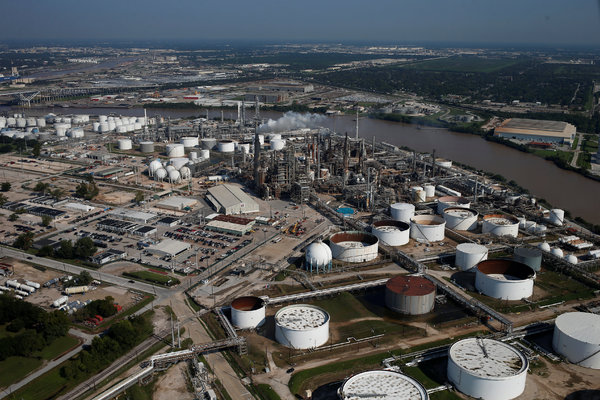High levels of the carcinogen benzene were detected in a Houston neighborhood close to a Valero Energy refinery, local health officials said, heightening concerns over potentially hazardous leaks from oil and gas industry sites damaged by Hurricane Harvey.
Preliminary air sampling in the Manchester district of Houston showed concentrations of up to 324 parts per billion of benzene, said Loren Raun, chief environmental science officer for the Houston Health Department. That is above the level at which federal safety officials recommend special breathing equipment for workers.
Health officials also detected high levels of volatile organic compounds, which have been linked to a variety of health problems, including liver damage and cancer.
Dr. Raun said that monitoring would continue, and that some readings showed far lower levels of the pollutants, depending on which way the wind was blowing. Still, “these are high numbers,” she said.
The Environmental Protection Agency said it was also focusing on “an area of potential concern” linked to emissions from a Valero facility. E.P.A. air monitoring buses would continue to test pollution levels around the Valero refinery and others in the area as they start back up, David Gray, an agency spokesman, said in a statement.
Manchester, a low-income neighborhood hemmed in by two freeways, a shipping lane and the Valero refinery, has long suffered from industrial pollution. Researchers have found elevated levels of childhood leukemia in several areas in Houston, including Manchester, a plight blamed on high levels of chemicals in the air.
Valero Energy, a refiner based in San Antonio, had told local regulators that a floating roof covering a tank at its Houston refinery sank on Aug. 27 in the heavy rains brought by Harvey, causing benzene to leak into the air. The leak lasted only until the next day, Valero had said in its filing with the Texas Commission on Environmental Quality.
Since Aug. 23, 31 facilities in 10 counties have reported an estimated 4.5 million pounds of excess emissions to the commission, an analysis by the Environmental Defense Fund and Environment Texas shows.
Lillian Riojas, a Valero spokeswoman, said that a “hurricane ride-out crew” of Valero workers had made sure that the oil that escaped from the roof was “quickly contained” and that “cleanup is well underway.” Valero was coordinating with both federal and local environmental regulators to monitor any emissions from the oil, she said.
Benzene, a toxic, flammable chemical found in crude oil and gasoline, is known to cause central nervous system damage and bone marrow damage, and is carcinogenic.
Elena Craft, a senior health scientist at the Environmental Defense Fund, said continued monitoring was essential; there were “a lot of unknowns” related to how long communities might have been exposed to the pollutants, and at what sustained concentrations.
The health risks were clear, she said.
“For the short term, the risks are dizziness, nausea, lightheadedness. But this could also play into your long-term cancer risks,” she said. “We’re very concerned about people’s long-term health in the area.”
Article originally appeared on nytimes.com by: Hiroko Tabuchi
Image:Adrees Latif/REUTERS


